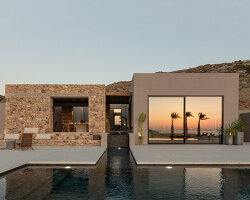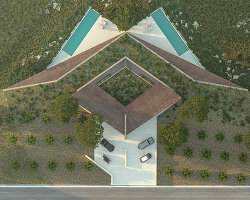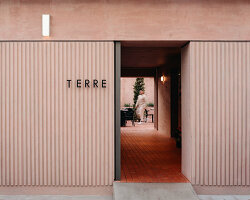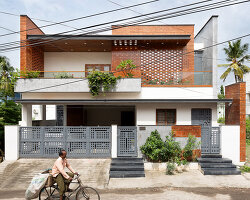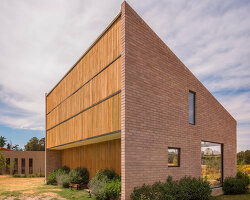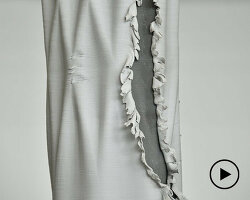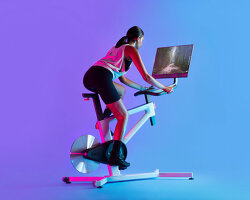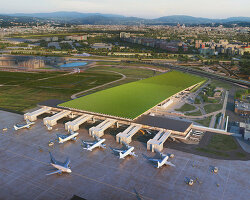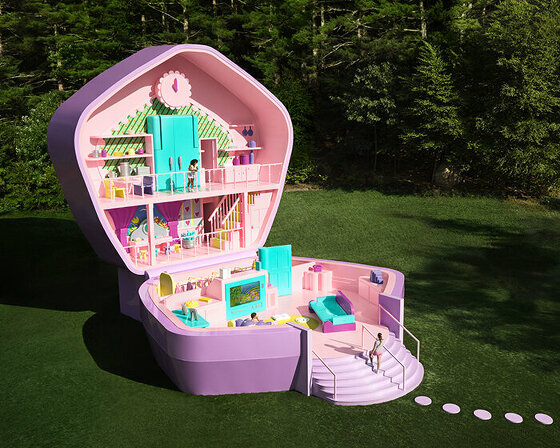researchers from gramazio kohler have collaborated with incon.ai, a spinoff recently launched by the robotic systems lab of ETH zurich, to develop a custom-made optical guidance system for constructing façades. using 13,596 individually rotated and tilted bricks, the design team used an augmented reality fabrication interface to build the façade of a winery in greece. this system was used by local masons to construct the 225 square meter façade in less than three months. the augmented bricklaying process, highlighted in the video at the top of this page, combines the power of computational design with the dexterity and skills of human craftspeople — introducing an entirely new fabrication paradigm.

image © michael lyrenmann | video © gramazio kohler research, michael lyrenmann, DTV production
gramazio kohler research — the chair for architecture and digital fabrication at ETH zurich — notes that the introduction of robotics into architecture still faces many barriers, including the limited mobility and dexterity of existing industrial robots, and the relative difficulty of automating and handling malleable building materials. to address these challenges, this project — titled ‘augmented bricklaying’ — reintroduces craftsmen into a digital fabrication process.

image © michael lyrenmann
‘by optically instructing masons with tailored digital information through a custom augmented reality user interface, a direct connection to the digital design model can be established,’ explains the team behind the project. ‘this craft-specific user interface allows masons to intuitively understand where to place the bricks according to the digital blueprint and computationally derived spatial model.’

image © michael lyrenmann
‘the technological innovation of this system uses visual-inertial object tracking features and real-time feedback to precisely relate what has already been physically built to the digital model, exceeding the accuracy of conventional holographic representations used as state of the art in this domain,’ continues gramazio kohler research. ‘through this augmented reality interface, the masons no longer depend on physical templates but can work with enhanced spatial precision while maintaining their craft and expertise in mortar handling.’

image © michael lyrenmann
located at the foot of mount olympus, overlooking the aegean sea, the newly constructed building at KITRVS winery will be used to process and store wine produced in the surrounding vineyards. the semi-transparent parametric façade has gaps between its individual bricks that allow for ventilation and control the amount of light that is able to enter. the configuration of the façade also produces a pattern of light that changes over the course of the day.

image © michael lyrenmann
‘through the re-introduction of craftsmanship into digital fabrication processes, ‘augmented bricklaying’ pursues a human centered approach to the notion of a fully automated building site,’ concludes the team. ‘augmented bricklaying can thus be understood as a way to overcome the known limitations of robotic automation, at the same time expanding the scope of digital fabrication through a socially sustainable model of digitalized building construction.’

image © michael lyrenmann

image © michael lyrenmann
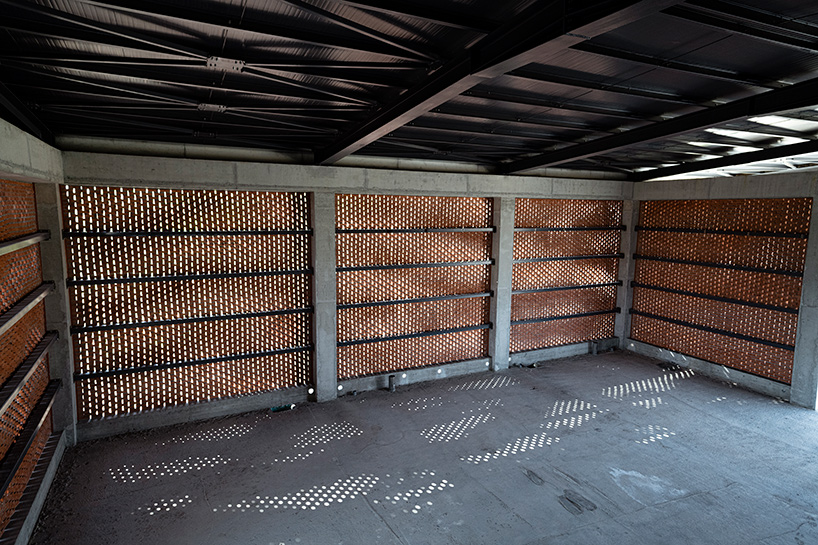
image © michael lyrenmann

image © michael lyrenmann

image © michael lyrenmann

image © michael lyrenmann
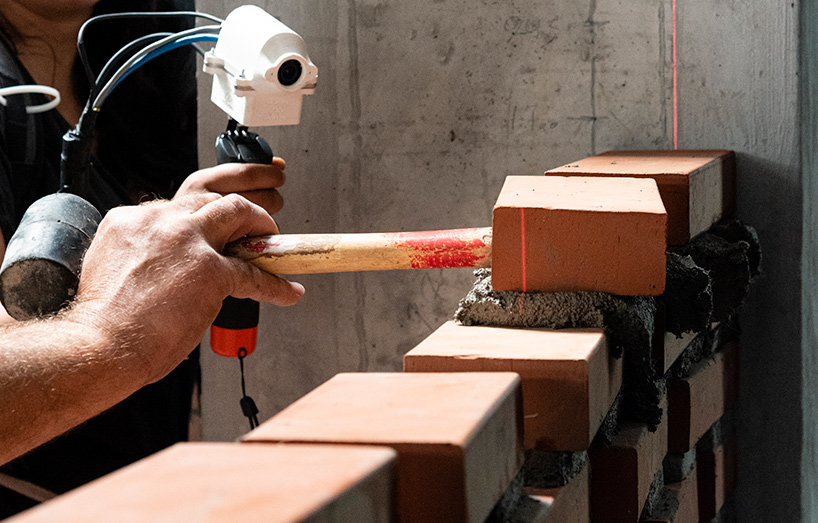
image © gramazio kohler research, ETH zurich

image © gramazio kohler research, ETH zurich

image © gramazio kohler research, ETH zurich
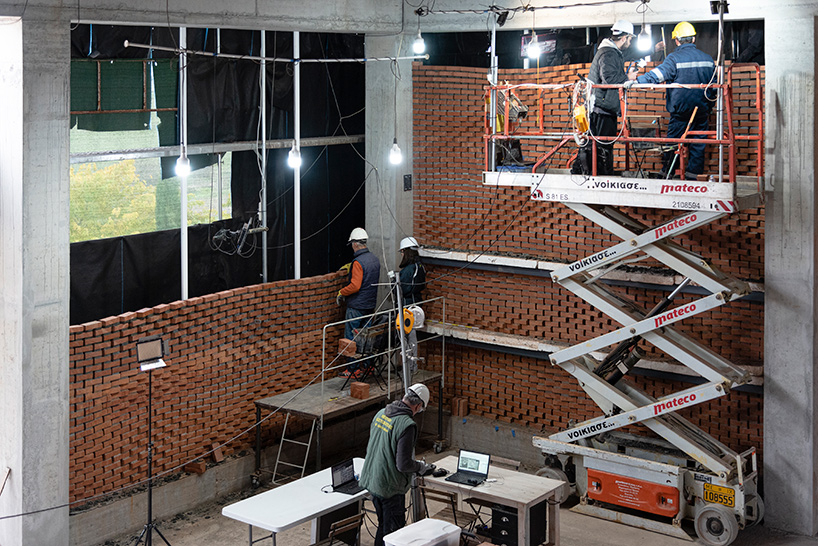
image © gramazio kohler research, ETH zurich
project info:
name: augmented bricklaying / KITRVS winery, greece
location: kitros, pydna, greece
architect: gramazio kohler research / ETH zürich
client: garypidis
program: winery
team: gramazio kohler research, ETH zurich
collaborators: dr. kathrin dörfler, daniela mitterberger, dr. timothy sandy, foteini salveridou, fernando cena, lukas stadl- mann, lefteris kotsonis, eleni alexi, dimitris ntantamis
consultancy: dr. nebojsa mojsilovic, structural masonry, ETH zurich
selected experts: tobias bonwetsch, ROB technologies. AR tracking system provided by incon.ai
photography: © michael lyrenmann, © gramazio kohler research
videos: © gramazio kohler research, © michael lyrenmann, © DTV production
design period: january 2019 – august 2019
fabrication period: september – december 2019
bricks: 13,596 locally sourced bricks
façade: infill masonry façade made of eight elements of 5×5 meter and three elements of 5×3 meters
size: 225 m2 of a double fair-faced brick façade
design: differentiation of brick courses through a variation of mortar height (5mm to 30mm). the rotation of the individual bricks was related to the amount of the underlying mortar (-20° to +20° rotation). the gap between the individual bricks was used to allow ventilation and light into the building and ranges from between 22 and 24mm
structural support: the structural support system of the fair-faced non-loadbearing façade consists of four horizontal bars per wall and custom-made metal blades cut, inserted and glued into the brick wall on-site
parametric digital design and fabrication model using grasshopper software, compas and python as a programming language. direct file-to-fabrication process
architecture in greece (258)
brick architecture (329)
ETH zurich (46)
gramazio kohler (12)
virtual and augmented reality (200)
winery architecture and design (69)
PRODUCT LIBRARY
a diverse digital database that acts as a valuable guide in gaining insight and information about a product directly from the manufacturer, and serves as a rich reference point in developing a project or scheme.
